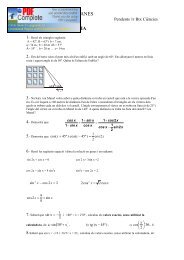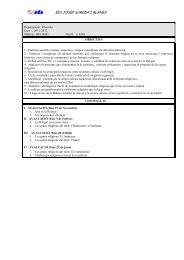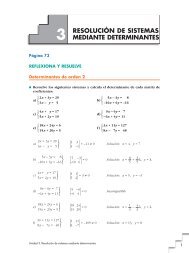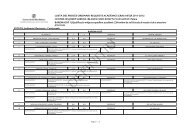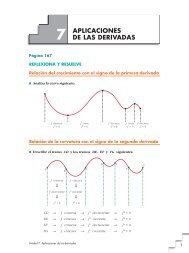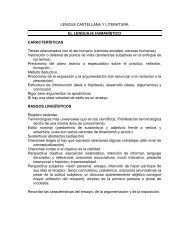Tema 6: Derivadas. Técnicas de derivación
Tema 6: Derivadas. Técnicas de derivación
Tema 6: Derivadas. Técnicas de derivación
You also want an ePaper? Increase the reach of your titles
YUMPU automatically turns print PDFs into web optimized ePapers that Google loves.
UNIDAD6Página 153° 2 – 3x, x Ì 21. f (x) = ¢£ x 2 – 3, x > 2¿Es <strong>de</strong>rivable en x 0= 2?lím f (x) = lím (2 – 3x) = –4x 8 2 – x 8 2 –límx 8 2 + f (x) = lím (x 2 – 3) = 1x 8 2 +La función no es continua en x = 2, pues límx 8 2 – f (x) ? límx 8 2 + f (x).Por tanto, tampoco es <strong>de</strong>rivable en x = 2.° 2 – 3x, x Ì 22. f (x) = ¢¿Es <strong>de</strong>rivable en x 0= 2?£ x 2 – 8, x > 2lím f (x) = lím (2 – 3x) = –4x 8 2 – x 8 2 –lím f (x) = lím (x 2 – 8) = –4x 8 2 + x 8 2 +La función es continua, pues: límx 8 2 – f (x) = lím f (x) = f (2) = –4.x 8 2 +° –3 si x < 2f'(x) = ¢£ 2x si x > 2f'(2 – ) = –3 ? f'(2 + ) = 4Por tanto, f (x) no es <strong>de</strong>rivable en x = 2.Página 1571. Calcula la <strong>de</strong>rivada <strong>de</strong> cada una <strong>de</strong> las siguientes funciones:1 – x1 – xa) f (x) = b) f (x) =1 + x√ 1 + x1 – x1 – tg xc) f (x) = ln d) f (x) =1 + x1 + tg x1 – tg xe) f (x) = f ) f (x) = ln√ 1 + tg x√3 x +1√e tg xg) f (x) = h) f (x) = log (sen x · cos x) 2i) f (x) = sen 2 x + cos 2 x + x j) f (x) = sen √x +1· cos √x – 1Unidad 6. <strong>Derivadas</strong>. <strong>Técnicas</strong> <strong>de</strong> <strong>de</strong>rivación3



